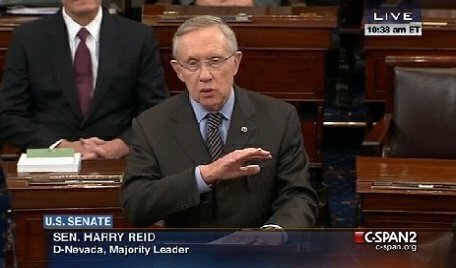Three years ago next month, Senate Democrats used the “nuclear option” to kill the filibuster for many Senate motions, but they left the option intact for Supreme Court nominees. Could that change in a matter of months?
 On November 21, 2013, then-Majority Leader Harry Reid led a Democratic Party push to mostly kill the filibuster, the tool used by minority parties in the past to block votes and motions in the Senate. Reid used a series of parliamentary tactics to change the number of votes needed to move motions onto the Senate floor for most presidential nominations, from 60 votes to 50 votes. The rules change applied to federal judge and executive-office nominees, but not to motions about Supreme Court nominees and legislation under consideration.
On November 21, 2013, then-Majority Leader Harry Reid led a Democratic Party push to mostly kill the filibuster, the tool used by minority parties in the past to block votes and motions in the Senate. Reid used a series of parliamentary tactics to change the number of votes needed to move motions onto the Senate floor for most presidential nominations, from 60 votes to 50 votes. The rules change applied to federal judge and executive-office nominees, but not to motions about Supreme Court nominees and legislation under consideration.
When the Republicans took back the Senate in January 2015, the party didn’t make good on previous threats to lower the vote needed to get a Supreme Court nomination to the Senate floor.
“When that happens [GOP control of the Senate], our side will likely nominate and confirm lower-court and Supreme Court nominees with 51 votes, regardless of whether Democrats actually buy into this fanciful notion that they demolish the filibuster on lower-court nominees and still preserve it for Supreme Court nominees,” Republican leader Chuck Grassley said back in November 2013.
In January 2017, it could be the Democrats pondering that move if the Republicans lose control of the Senate after the November 2016 general election. By many estimates, there are six deeply contested Senate seats left undecided just two weeks before the election. The Democrats need to take three of those six seats if Hillary Clinton wins on November 8, or four seats if Donald Trump wins, to assume control of the Senate.
And in a scenario where Clinton wins the election and the Democrats take control of the Senate, the filibuster would be the only tactic left to Republicans wishing the block the confirmation of a Justice they oppose from getting a vote.
Under the Constitution, the President nominates a Supreme Court candidate to the Senate for confirmation. Once the nomination is approved by and sent to the entire Senate for a floor vote, a simple majority is needed to confirm the nominee. However, 60 votes are needed under cloture rules for the nomination to make it to the floor. By most estimates, even if the Democrats take back Senate control in a best-case scenario, they would have 53 votes in hand on straight party lines.
Given the recent tradition of close scrutiny of Supreme Court nominees, another “nuclear” move to kill the Supreme Court nominee filibuster would be controversial.
How would that work? In November 2013, Reid used a tactic to raise a point of order that only a majority of senators was needed for a cloture vote, or a vote to override a filibuster. Judiciary Committee Chairman Patrick Leahy then acted as the Senate parliamentarian and said that the historic precedent required 60 votes in a cloture vote. Reid then won a 52-48 vote to overrule Leahy’s decision. The act is the biggest Senate rule change since 1975, when the cloture vote threshold was lowered from two-thirds of the Senate.
As of today, 223 days have passed since President Barack Obama nominated Merrick Garland to replace the late Justice Antonin Scalia on the bench. If Garland isn’t confirmed in the lame-duck session between Election Day and the end of the current Congress, the Senate will need to take up Garland’s nomination again – or the nomination of another candidate – in early January 2017.
Reid, who is retiring after the current election, recently told the website Talking Points Memo that Democrats should use his example from 2013 and eliminate the Supreme Court filibuster if they take back the Senate and can’t get a nomination onto the floor for a vote.
“It’s clear to me that if the Republicans try to filibuster another circuit court judge, but especially a Supreme Court justice, I’ve told 'em how and I’ve done it, not just talking about it. I did it in changing the rules of the Senate. It’ll have to be done again," Reid said.
Last week, Reid’s potential heir as Senate Majority leader, Chuck Schumer told CNBC that “I hope we won't get to that” when asked about a potential Supreme Court filibuster change.
The significance of changing the filibuster rule could be far-reaching and politically volatile, but filibusters against Supreme Court nominees are rare. In 2006, a brief, failed effort was launched against Samuel Alito’s nomination that included Senator Barack Obama. In 1968, a successful effort was made against Abe Fortas’s nomination to Chief Justice that may have been a filibuster.
Scott Bomboy is the editor in chief of the National Constitution Center.






